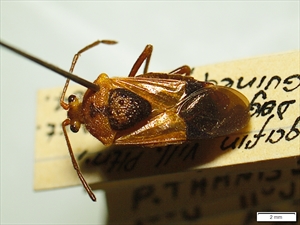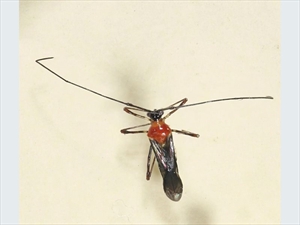Cocoa mirids
Pacific Pests, Pathogens and Weeds - Online edition
Pacific Pests, Pathogens & Weeds
Cocoa mirids (274)
Helopeltis clavifer and Pseudodoniella species (Pseudodoniella typica, Pseudodoniella laensis, Pseudodoniella pacifica).
Helopeltis clavifer occurs in Indonesia, where it was first described, Malaysia and mainland Papua New Guinea, from sea level to 1000 m. It is also present in New Britain and New Ireland, but does not attack cocoa there.
Pseudodoniella laensis is present in mainland Papua New Guinea, and in Irian Jaya; Pseudodoniella typica and Pseudodoniella pacifica are present in the islands of Papua New Guinea; Pseudodoniella pacifica occurs above 500 m.
Helopeltis clavifer occurs on cocoa and tea, and many other hosts, whereas Pseudodoniella occurs only on cocoa and fig (Ficus) species.
Mirid adults and nymphs suck the sap from cocoa pods producing 3 mm diameter spots, which are brown at first then black. Young pods ('cherelles') less than 10 cm long are destroyed, more mature pods are deformed and beans are smaller than those in healthy pods. Mirids also feed on young shoots and branches and cause dieback.
The damage done by mirids is thought to be mechanical destruction of the cells around the stylets or feeding tubes, the loss of cell sap, as well as damage caused by chemicals in the saliva injected as the mirids feed. It has been shown that the saliva of Helopeltis can remove cell contents without mechanically damaging the cells, and this can happen up to 3.5 mm from the stylet. It is presumed that this occurs by osmosis. [The coreid bug, Amblypelta, feeds in a similar way (see Fact Sheet no. 19)].
Eggs are laid beneath the outer layers of cocoa pods, and sometimes on young shoots. They hatch in about 7 days (Helopeltis) or 14 days (Pseudodoniella), and moult six times before becoming adults, 10-14 days later. However, there are differences between the two: (i) Helopeltis lives longer (about 40 days) compared to Pseudodoniella (about 10 days); (ii) Helopeltis has a wide host range, whereas that of Pseudodoniella is narrow; and (iii) body shapes differ - Pseudodoniella species are about 8 mm long by 4 mm wide, and have a swelling ('hump') on the top of the thorax (Photos 1&2); by contrast, Helopeltis is slender, with antennae longer than the body, and a diagnostic spine on the back between the thorax and abdomen (Photo 3).
Direct damage is done when mirids feed on young and mature pods, and shoots, and indirectly when fungi enter wounds caused by their feeding. In Papua New Guinea, mirid damage is common wherever cocoa is grown except for the North Solomon Province, and often severe. Losses from Helopeltis and Pseudodoniella has been estimated to be from 10-95% in Papua New Guinea.
Look for the 'humps' on the thorax of Pseudodoniella, which is very unusual but characteristic of this bug; by contrast, Helopeltis is slender, and characterised by its common name 'mosquito bug'. Look for the bugs feeding on cocoa with long slender mouthparts which leave black spots on the pods, especially on the young ones, and cause dieback by feeding on the shoots.
NATURAL ENEMIES
There are no known effective parasitoids in Papua New Guinea, but there are many predators that have been used elsewhere for control, or are thought to have potential. Most of these are ants. Wasmannia auropunctata is said to be used in cocoa in The Republic of Cameroon. In Papua New Guinea, Oecophylla smaragdina is believed to be a good control agent, and that crazy ants, Anoplolepsis longipes, can eliminate both Helopeltis and Pseudodoniella from plantations.
Note, the use of ants in this way needs careful consideration, especially the use of Wasmannia which can make harvesting and routine maintenance of cocoa unpleasant because of the ants' painful sting.
CULTURAL CONTROL
Leucaena leucocephala is commonly used as a shade for cocoa, but it should be avoided where mirids are a problem. It is an alternative host for them. Using coconut as a shade has the benefit of providing nesting sites for certain ant species which may be mirid predators; however, it is not easy to predict which ant will be dominant in coconut plantations, and manipulating the species to get the optimum benefit is not easy (or sometimes possible).
CHEMICAL CONTROL
In the past, pesticides were recommended for control of mirids in cocoa that have since been banned by international treaties. Lindane (BHC), previously used as a dust or spray, is one such chemical. The pesticides now recommended are imidacloprid, and the synthetic pyrethroid, bifenthrin. As the mirids are usually clumped in the plantations, spraying is concentrated on these 'hot-spots', rather than a blanket spray throughout. Usually, four sprays are applied per year, but with systemic products this may be reduced to two.
____________________
When using a pesticide, always wear protective clothing and follow the instructions on the product label, such as dosage, timing of application, and pre-harvest interval. Recommendations will vary with the crop and system of cultivation. Expert advice on the most appropriate pesticides to use should always be sought from local agricultural authorities.
AUTHOR Grahame Jackson
Information from Moxon JE (1992) Insect pests of cocoa in Papua New Guinea, importance and control. In: Keane PJ, Putter CAJ (eds) 'Cocoa pest and disease management in the Southeast Asia and Australasia'. FAO Plant Production and Protection Paper 112, pp 129-144. Rome; and Hori K (2000) Possible cause of disease symptoms resulting from the feeding of phytophagous heteroptera. In: Schaefer CW, Panizzi AR (eds.) 'Heteroptera of economic importance'. CRC Press, pp 11-36. Photo 3 Graeme Cocks Bowerbird. (http://www.bowerbird.org.au/observations/21199); and from End MJ, et al. (Eds.) 2017. Technical guidelines for the safe movement of cacao germplasm. Revised from the FAO/IPGRI Technical Guidelines No. 20 (Third Update, October 2017). Global Cacao Genetic Resources Network (CacaoNet), Bioversity International, Rome, Italy. (https://www.cacaonet.org/fileadmin/templates/CacaoNet/Uploads/publications/Safe_Movement_Guidelines_2017_En.pdf).
Produced with support from the Australian Centre for International Agricultural Research under project PC/2010/090: Strengthening integrated crop management research in the Pacific Islands in support of sustainable intensification of high-value crop production, implemented by the University of Queensland and the Secretariat of the Pacific Community.






